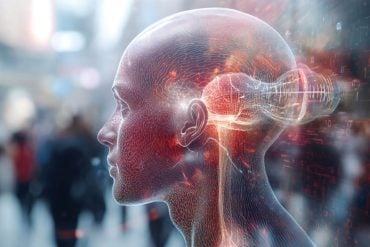Summary: Researchers have unveiled a groundbreaking discovery in the field of pain management: an alternative pathway in the brain that provides relief similar to opioids but without the addiction risks. This mechanism leverages the neurotransmitter acetylcholine in the ventrolateral periaqueductal gray (vlPAG) region of the brain.
By targeting the acetylcholine receptor alpha-7 (⍺7), the team observed a lasting analgesic effect in mice, even those tolerant to opioids. This finding offers new opportunities for drug development, potentially revolutionizing pain treatment.
Key Facts:
- The acetylcholine receptor alpha-7 (⍺7) in the vlPAG provides a prolonged analgesic effect when stimulated.
- This non-opioid mechanism remains effective even in animals with opioid tolerance and lacks addictive properties.
- The new discovery opens avenues for the development of analgesics that target acetylcholine or the ⍺7 receptors, offering comparable relief to opioids without the drawbacks.
Source: University of Chicago
The opioid epidemic in the United States has exacted an incalculable toll on individuals and communities, creating an urgent need for alternative painkillers. The search for non-opioid treatments is crucial, not only to mitigate the risks of addiction and overdose, but also to develop pain management tools that remain effective without inducing tolerance and other challenging side effects in patients.
New research from the University of Chicago identified an alternative signaling pathway in the brain of mice that relieves pain, even in animals that have developed tolerance to opioids.

The study, published in Neuron in September, also showed that pain relief through this route did not induce tolerance, did not create withdrawals symptoms after treatment was stopped, and did not activate reward systems, limiting risk for addiction and making it a viable path to developing effective, non-opioid pain relief.
“There are multiple categories of non-opioid treatments, but the bad news is that nothing currently compares to opioids for the level of pain relief,” said Daniel McGehee, PhD, Professor of Anesthesia and Critical Care at UChicago and senior author of the new study.
“Any alternative is a welcome option, and we have found pain control circuitry here that can produce relief similar to what we see with opioid activity, without the downsides.”
A different circuit for pain relief
The ventrolateral periaqueductal gray (vlPAG) is an area of the brain that serves as an important crossroads of systems that control pain. Previous research has shown that electrical stimulation and pharmacological treatments targeting this region can relieve pain, although the non-opioid circuits that alter pain through changes in activity in this part of the brain are less well-studied.
One of these circuits involves the neurotransmitter acetylcholine, which affects activity in multiple parts of the brain. Targeting acetylcholine receptors can change pain responses, but the mechanisms by which naturally produced acetylcholine regulates pain control circuitry in the vIPAG had not been explored.
McGehee and Shivang Sullere, PhD, a previous graduate student in the Committee on Neurobiology at UChicago, now a postdoctoral scholar at the Harvard Medical School and the new study’s first author, investigated the dynamics of how acetylcholine is released in this area of the brain under various pain states, like inflammation, chronic neuropathy, or acute pain.
McGehee’s lab published a paper in 2017 showing that targeting an acetylcholine receptor in the vIPAG called alpha-7 (⍺7) produced an analgesic effect. One might expect that the body would take advantage of this and release more acetylcholine in a painful scenario, but instead, the researchers saw the opposite effect—it was being suppressed. The team then set out to understand how and why this was happening.
The ⍺7 receptor is usually an excitatory receptor, meaning that it generates more activity in the nervous system. But when the researchers injected a drug that stimulates ⍺7 into the mice, the cells’ initial excited state quickly gave way to a prolonged quiet state, producing an analgesic effect that lasted for several hours.
“That was a huge and extremely unexpected outcome,” McGehee said. “Persistent inhibition was not on our radar at all. It was always a conundrum to me, but we saw that there is recruitment of another signaling pathway that is altering potassium channel function and causing these cells to shut down.”
When the team tested the effects of boosting acetylcholine in mice that had tolerance to opioids, they saw the same long-lasting analgesic effects. That’s because the acetylcholine receptor is part of a different pathway than that used by opioids—the two operate independently, and if tolerance develops in the opioid circuits, acetylcholine’s effects are not altered.
The animals also didn’t show signs of dependence or preference for environments where they received the drug that stimulated more acetylcholine in the absence of pain, which is a good sign that it doesn’t have addictive properties.
Separate imaging experiments also showed that higher levels of activity in cells that express ⍺7 correlated with higher levels of pain experienced by the animals: when those same cells were suppressed, pain was reduced as well.
“Not only do these cells relieve pain, they also accurately mirror the pain state of the organism. Through imaging methods, we can reproducibly monitor these neurons and acetylcholine in the vlPAG. This provides us a valuable biomarker for the pain state of an organism,” Sullere said.
“This unexplored role of acetylcholine also points towards its potential involvement in the central sensitization processes that contribute to the development of chronic pain conditions. Modifying acetylcholine signaling provides an opportunity to relieve pain and prevent the establishment of the chronic pain state.”
Opportunities for new pain-relieving drugs
The results of this work point to multiple opportunities to develop new pain-relieving drugs, either by stimulating the release of acetylcholine or targeting ⍺7 receptors. McGehee said medications targeting these receptors have been tested for multiple diseases, but not yet as painkillers.
“This is a potentially valuable target for new development of analgesics,” he said. “We see that inhibiting these cells is important in terms of controlling pain, and it’s a very profound mechanism that works beautifully and to a similar degree to what we see with opioids.”
Funding: The study, “A Cholinergic Circuit That Relieves Pain, Despite Opioid Tolerance,” was supported by the National Institutes of Health (grants R21DA046184, R21NS120582, and R21NS110371). Alissa Kunczt, a former student at UChicago and now in the MD/PhD program at University of Wisconsin, Madison, was an additional author.
About this pain and neuropharmacology research news
Author: Matt Wood
Source: University of Chicago
Contact: Matt Wood – University of Chicago
Image: The image is credited to Neuroscience News
Original Research: Open access.
“A cholinergic circuit that relieves pain despite opioid tolerance” by Daniel McGehee et al. Neuron
Abstract
A cholinergic circuit that relieves pain despite opioid tolerance
Highlights
- Acute and chronic pain decrease ACh in the ventrolateral periaqueductal gray (vlPAG)
- Activating PPTgChAT+ → vlPAG projections relieves somatic and affective pain behaviors
- α7 nAChRs mediate these analgesic effects by inhibiting vlPAGGABA+ neurons
- Analgesic potency of this cholinergic circuitry is preserved despite opioid tolerance
Summary
Chronic pain is a tremendous burden for afflicted individuals and society. Although opioids effectively relieve pain, significant adverse outcomes limit their utility and efficacy. To investigate alternate pain control mechanisms, we explored cholinergic signaling in the ventrolateral periaqueductal gray (vlPAG), a critical nexus for descending pain modulation. Biosensor assays revealed that pain states decreased acetylcholine release in vlPAG.
Activation of cholinergic projections from the pedunculopontine tegmentum to vlPAG relieved pain, even in opioid-tolerant conditions, through ⍺7 nicotinic acetylcholine receptors (nAChRs). Activating ⍺7 nAChRs with agonists or stimulating endogenous acetylcholine inhibited vlPAG neuronal activity through Ca2+ and peroxisome proliferator-activated receptor α (PPAR⍺)-dependent signaling.
In vivo 2-photon imaging revealed that chronic pain induces aberrant excitability of vlPAG neuronal ensembles and that ⍺7 nAChR-mediated inhibition of these cells relieves pain, even after opioid tolerance.
Finally, pain relief through these cholinergic mechanisms was not associated with tolerance, reward, or withdrawal symptoms, highlighting its potential clinical relevance.






